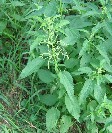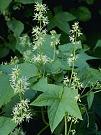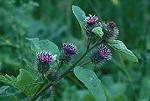

Noxious Plants are what we refer to as plants which should generally be avoided on hikes, since in many people they result
in an uncomfortable allergic reaction.
Following are descriptions of the most common such plants as found along the Hockanum River trails. While a sample
Web page is provided, you can find additional information by typing in the name of the plant into a standard Web search
engine such as Google.
Poison Ivy:
 Poison ivy is a very common plant found in most parts of the United States. It has 2 forms: One form grows low to the ground.
It is usually found in groups of many plants and looks like weeds growing from 6 to 30 inches high. The other form is a
hairy vine that grows up a tree. Both have stems with 3 leaves.
Poison ivy is a very common plant found in most parts of the United States. It has 2 forms: One form grows low to the ground.
It is usually found in groups of many plants and looks like weeds growing from 6 to 30 inches high. The other form is a
hairy vine that grows up a tree. Both have stems with 3 leaves.
To get more information on Poison Ivy click on: Poison Ivy.
Stinging Nettle:
 Stinging Nettles are plants which stand up to 2-4 feet high and which, if brushed by exposed skin, can result in an
immediate and painful reaction. This is the caused by needles which are part of the plant and which release acid as a
defense mechanism. The reaction can last from a half to several hours, depending on the sensitivity of the person affected.
Stinging Nettles are plants which stand up to 2-4 feet high and which, if brushed by exposed skin, can result in an
immediate and painful reaction. This is the caused by needles which are part of the plant and which release acid as a
defense mechanism. The reaction can last from a half to several hours, depending on the sensitivity of the person affected.
To get more information on Stinging Nettles click on:
Stinging Nettle.
Wild Cucumber:
 The Wild Cucumber is an annual, tendril-bearing, climbing vine often reaching 20 feet in length. Its fruit resembles a
cucumber, but is not edible. This is considered a noxious plant because the length and density of the vines can often
overwhelm plants they grow on, resulting in their being bowed over and eventually killed. Thus it's more noxious to
plants than people; but is no less a nuisance for all that.
The Wild Cucumber is an annual, tendril-bearing, climbing vine often reaching 20 feet in length. Its fruit resembles a
cucumber, but is not edible. This is considered a noxious plant because the length and density of the vines can often
overwhelm plants they grow on, resulting in their being bowed over and eventually killed. Thus it's more noxious to
plants than people; but is no less a nuisance for all that.
To get more information on the Wild Cucumber click on:
Wild Cucumber.
Great Ragweed:
 The Great Ragweed (or Giant Ragweed) is a tall, rough hairy plant with elongated terminal clusters of nodding male heads
above a few clusters of female flower heads. Its pollen is spread by wind rather than by insects. This plant is a major
cause of hay fever allergies, and can irritate the skin if touched. It can also be toxic to livestock.
The Great Ragweed (or Giant Ragweed) is a tall, rough hairy plant with elongated terminal clusters of nodding male heads
above a few clusters of female flower heads. Its pollen is spread by wind rather than by insects. This plant is a major
cause of hay fever allergies, and can irritate the skin if touched. It can also be toxic to livestock.
To get more information on the Great Ragweed click on:
Great Ragweed.
Common Burdock:
 Common Burdock is a large, bushy plant with globular, prickly pink-to-lavendar flower heads, approximately 3/4 inches wide.
The prickly heads of these plants easily catch on fur and clothing, providing an excellent method of seed dispersal but a
nuisance to hikers whose clothing and equipment can quickly become infested with them.
Common Burdock is a large, bushy plant with globular, prickly pink-to-lavendar flower heads, approximately 3/4 inches wide.
The prickly heads of these plants easily catch on fur and clothing, providing an excellent method of seed dispersal but a
nuisance to hikers whose clothing and equipment can quickly become infested with them.
To get more information on the Common Burdock click on:
Common Burdock.